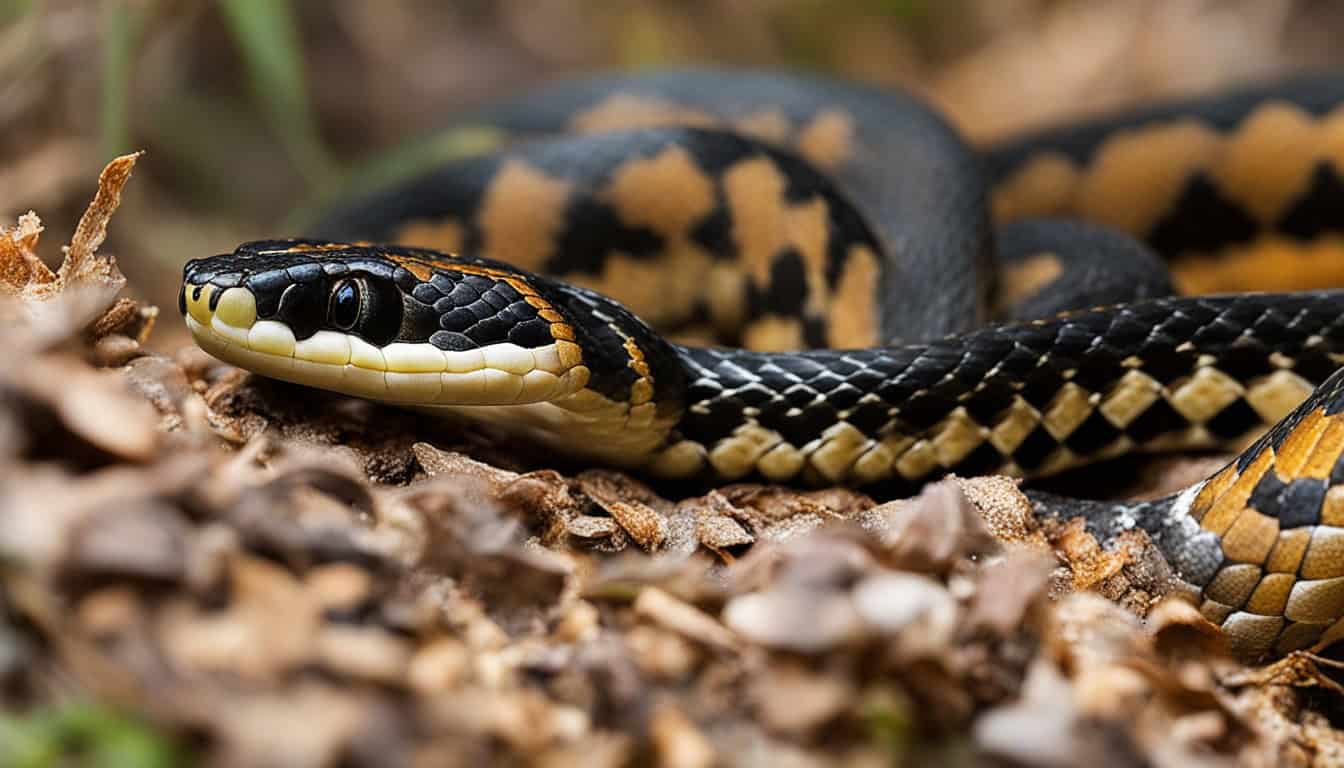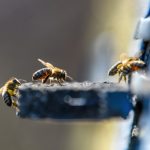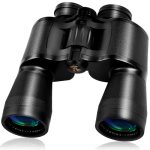Have you ever wondered how many snakes live in the USA? There are about 150 snake species in different parts of North America. It’s interesting to note that Alaska, with its cold weather, doesn’t have any native snakes.
Snakes in the USA have unique bodies. They have no legs or ears and they can open their mouths very wide. This lets them live in many places. In the U.S., there are snakes like rattlesnakes, copperheads, and more that can be dangerous. But, there are also many that are not harmful, like garter snakes. Each snake plays its part in keeping the environment balanced. Want to know more about American snakes? Check out our detailed list to explore these interesting animals!
Overview of Snakes in the United States
The United States is home to many native snake species. You can find garter snakes and kingsnakes, among others. This variety shows America’s rich ecosystem.
Garter snakes are common across the country. These non-venomous snakes help control pests. They eat insects and small rodents in gardens and parks.
There are also venomous snakes in the U.S. This includes rattlesnakes and cottonmouths. They are known for their unique features and behavior. These snakes are found in different environments.
Let’s compare the venomous and non-venomous snakes found in the USA:
| Type | Species | Characteristics | Common Habitat |
|---|---|---|---|
| Non-Venomous | Garter Snake | Small to medium-sized, often near water sources | Gardens, parks, wetlands |
| Non-Venomous | Kingsnake | Colorful patterns, immune to other snake venoms | Forests, grasslands, urban areas |
| Venomous | Rattlesnake | Rattle at the end of the tail, triangular head | Deserts, rocky areas, grasslands |
| Venomous | Cottonmouth | Thick-bodied, often found near water | Swamps, wetlands, rivers |
These snakes can live in many places. Even though you see more non-venomous snakes, venomous ones are vital too. They all have a key part in their habitats.
Learning about the snakes in the U.S. is important. It helps us understand and value their role in nature. This knowledge allows us to live with them peacefully and support their conservation.
Venomous Snakes in North America
North America is home to several venomous snake types. Four, in particular, are quite notable for their unique venom and features. Knowing about these snakes and where they live is crucial for outdoor enthusiasts.
Rattlesnakes
Rattlesnakes stand out as some of North America’s most well-known venomous snakes. They can be identified by the rattle on their tail. This rattling acts as a warning. Rattlesnakes live in a variety of places, from deserts to grasslands. They have adapted to thrive in different climates.
Cottonmouths (Water Moccasins)
Cottonmouths, or Water Moccasins, are found in the southeast near water sources. They show a distinctive defense stance, revealing their white mouths. This display warns off potential threats. Swamps, marshes, and waterfronts are their common places.
Copperheads
Copperheads blend well with their surroundings, making them hard to spot. They live in the east part of the U.S. Knowing where they live is important for those who enjoy the outdoors. Though they usually avoid people, they might bite when disturbed.
Coral Snakes
Coral snakes are known for their bright, colorful patterns. Even though they are small, their venom is very potent. They live in the south and like sandy, wooded areas.
It’s important to learn to recognize these snakes. Doing so can keep you safe and help you value their place in nature.
Non-Venomous Snakes in the United States
The United States has many non-venomous snakes. They are often overlooked because they’re not dangerous to people. However, they are very important. They help keep nature in balance by eating pests.
Garter Snakes
Garter snakes are one of the most common non-venomous snakes in the United States. They can be found in many places, including gardens and near water. These snakes eat insects, small fish, and amphibians.
Kingsnakes
Kingsnakes are unique because of their cool patterns and what they eat. They can even eat other snakes, including venomous ones. This helps keep harmful snake numbers low. Kingsnakes live in a variety of places, from forests to deserts.
Water Snakes
Water snakes mostly live near water, like lakes and rivers. Sometimes, they’re mistaken for venomous water snakes, such as cottonmouths. Learning about water snake distribution can help tell them apart and highlight their importance in water ecosystems.
| Snake Species | Diet | Habitats |
|---|---|---|
| Garter Snakes | Insects, small fish, amphibians | Gardens, near water sources |
| Kingsnakes | Other snakes, rodents, birds | Forests, deserts |
| Water Snakes | Fish, amphibians | Near lakes, rivers, ponds |
What Types of Snakes Are Found in the USA?
The USA is home to many snake species, from harmless to dangerous ones. For example, you might see a friendly garter snake in the wild or even in your backyard. It doesn’t pose a threat to people.
On the other hand, there are also dangerous snakes like rattlesnakes. They have venom that can be harmful to humans. It’s important to learn about all the *American snakes* so you can identify them.
This knowledge helps us appreciate snakes in nature. It also makes it easier to share our environment with them. By understanding snakes, we reduce fear and keep everyone safer.
Snakes of the Western United States
The Western United States is home to many snake species. They live in a variety of places, from the coast to the desert. This makes the area rich in snake diversity.
California Mountain Kingsnake
The California Mountain Kingsnake is famous for its bright, banded pattern. It looks like the venomous coral snake. This helps it stay safe. You can mainly find them in California’s mountains. They live in forests and on rocky ground. Their meals include small mammals, birds, and other snakes.
Rubber Boa
The Rubber Boa stands out with its shiny, smooth skin. It’s known for being calm. Unlike some snakes, it doesn’t mind being handled. You can see Rubber Boas in woodlands, grasslands, and chaparral. They eat small rodents and lizards. This helps to keep the ecosystem balanced.
The California Mountain Kingsnake and Rubber Boa show how snakes in the West adapt well. They live in various environments. This boosts the area’s biodiversity.
| Species | Habitat | Diet |
|---|---|---|
| California Mountain Kingsnake | Forests, rocky terrains | Small mammals, birds, reptiles |
| Rubber Boa | Woodlands, grasslands, chaparral | Small rodents, lizards |
Southern US Snake Species
In the southern United States, many snake types are vital for the environment. Among them are the very fast Eastern Racers and the beautifully patterned Great Plains Ratsnake.
Eastern Racers
Eastern Racers are known for their speed and moving with ease. They are thin and have smooth skin, living in various places like forests and fields. Knowing where Eastern Racers habitat is, helps us see their importance. They help keep the number of small animals and bugs in check.
Great Plains Ratsnake
The Great Plains Ratsnake stands out because of its detailed patterns and love for digging. Found commonly in the Southern US, understanding Great Plains Ratsnake identification is key. They play a big part in controlling the number of rodents. Their light colors and liking for night hunting help them be good at what they do.
These snakes show us how important Southern US snake species are in the local food chain. They are both hunters and can be hunted, helping keep nature’s balance.
Northeastern US Snake Species
The Northeastern United States has many snake types. These snakes do amazing things and adjust to their environment. Some examples include the Milk Snake and the Northern Water Snake.
- Milk Snake
- Northern Black Racer
- Northern Water Snake
- Smooth Green Snake
Northeastern US snakes change with the seasons a lot. They find places to hide during cold winters. This helps them survive when it gets very chilly.
These snakes play an important role in nature. They eat pests, keeping the environment healthy. Plus, they show us how good their living areas are. It’s key to know the native snake identification of these creatures to see their impact in the Northeast.
Habitats of Snakes in the USA
In the USA, snakes make their home in many places, from gardens to forests. Garter snakes are often found in gardens and wild lawns. They use these areas for protection and to catch small animals. Green snakes, on the other hand, climb trees really well.

You might see snakes in the basements of old houses. They go there to escape bad weather. So, even in water areas, snakes are common. Aquatic snakes live in these places. Some people mistake them for dangerous snakes because they look alike.
Learning about where snakes like to live helps us understand them. Below, is a table that compares different snake homes in the USA.
| Habitat Type | Notable Species | Characteristics |
|---|---|---|
| Gardens and Yards | Garter Snakes | Adaptable, live near humans, control pests |
| Trees | Green Snakes | Arboreal, slender, blend into foliage |
| Basements | Various small species | Seek warmth and shelter away from cold |
| Water Bodies | Water Snakes | Non-venomous, live near streams, ponds, lakes |
Knowing where snakes like to live shows their importance in the environment. It helps us live well with these interesting animals.
Snake Identification Guide USA
A comprehensive snake identification guide USA can help you tell snakes apart. Knowing how to spot difference traits keeps you safe and lets you admire these creatures.
Identifying snakes starts with noticing their coloration and scale patterning. This helps you tell them apart. For example:
- Venomous Snakes: Have clear warning signs like the bright bands of coral snakes or the diamond shapes on rattlesnakes.
- Non-Venomous Snakes: Look more plain and have many colors. Garter snakes are a good example.
Head shape and pupil size are also important. Venomous snakes have triangle-shaped heads and cat-eye pupils. Non-venomous ones have round heads and pupils.
Sensory pits can help too. Pit vipers like rattlesnakes, copperheads, and cottonmouths have special pits to sense heat. These pits are missing in non-venomous snakes.
Having a snake identification guide USA helps us stay safe around these interesting animals.
- Venomous Snake Features: Focus on obvious traits like scale patterns, head shape, and sensory pits.
- Non-Venomous Snake Characteristics: They usually have more common colors, round pupils, and no sensory pits.
Learning how to identify snakes is key. It helps keep you safe and teaches you about their important role in nature.
Benefits of Snakes to the Ecosystem
Snakes are very important for keeping ecosystems healthy. They eat rodents, insects, and other prey, helping control their numbers. This means there are not too many pests that could harm crops and natural plants. So, snakes play a key part in keeping the natural balance just right.
Not only do snakes eat small creatures, but they are food for other animals too. Creatures like birds of prey and mammals depend on snakes for their food. This shows how snakes are vital in the food chain, helping keep the ecosystem diverse and healthy. They also show if an area is doing well because they need a healthy environment to survive.
Here’s a closer look at how certain snake roles in ecosystems manifest:
| Snake Role | Impact on Ecosystem |
|---|---|
| Predators | Control populations of rodents and pests, preventing overpopulation and protecting vegetation and crops. |
| Prey | Provide food for birds of prey, mammals, and other reptiles, supporting higher trophic levels. |
| Bioindicators | Indicate a healthy environment, as their presence reflects the overall quality and biodiversity. |
By appreciating what snakes do for the environment, we can help protect them better. This means creating spaces where snakes and other animals can live well together. It’s important for the health of our planet.
Safety Tips for Encountering Snakes
Meeting a snake is unexpected and can be scary. But, safety is key when we deal with them. To lower the chance of meeting snakes, follow wildlife encounter tips. These tips make sure you and the snakes are safe. Let’s go over them:
- Maintain Clean Environments: Keep your yard tidy and without too much stuff. Snakes like to hide in messy places.
- Avoid Attracting Prey: Close food tightly and get rid of places where mice live. These things make snakes come close.
- Keep a Safe Distance: If you spot a snake, don’t touch it. Be far away and just watch it from a distance.
- Contact Professionals: Lots of snakes or dangerous ones need experts. They can remove snakes without hurting them.
Following these wildlife encounter tips helps keep you and your family safe. It lets everyone live well with nature, even snakes.
Conservation Status of US Snakes
The state of snakes in the United States is complicated. Many of them are not in danger. But, some face serious risks like loss of their homes, growing cities, and actions by people. For example, the eastern indigo snake and a few San Francisco garter snakes enjoy special legal protection. This shows we need to act now to keep them safe.
As more and more homes disappear, snakes need protection to survive. States and the country have laws that help. These laws aim to save snakes and their homes. They encourage growing back their living spaces, making laws to protect them, and teaching people how important snakes are to nature.
We must learn and do more to keep US snakes healthy. We can help by telling others and getting involved in saving snakes. Saving them also means saving our crops from pests. Plus, snakes help keep nature in balance. So, saving them is key to a healthy environment.
FAQ
What types of snakes are found in the USA?
The USA is home to about 150 snake species. This includes both venomous and non-venomous kinds. You can find them in deserts, forests, and more. Examples are rattlesnakes, kingsnakes, garter snakes, and others.
What are some of the common snakes in the USA?
Garter snakes, kingsnakes, water snakes, and rat snakes are common here. You might see them in gardens, forests, and near where people live. They’re familiar sights.
Which snakes are venomous in North America?
Rattlesnakes, cottonmouths, copperheads, and coral snakes are venomous in North America. They live in different places on the continent. Each has a special way to deliver venom.
What are the characteristics of rattlesnakes?
Rattlesnakes warn with their tails’ loud sound. They’re experts at finding prey with their heat-sensing pits. These snakes normally live in dry, rocky places.
Where are cottonmouths typically found?
Cottonmouths, or water moccasins, like the southeast’s wet areas. Think of swamps, marshes, and rivers. They’re good swimmers but get defensive when they feel threatened.
How can you identify copperheads?
Copperheads stand out with their copper-toned heads and shaped bands. They’re great at hiding among forests and leaves. You’ll mostly find them in the east.
What distinguishes coral snakes from other snakes?
Coral snakes have bright color bands and are very venomous. They mainly live in the south. Their pattern is a warning.
What are the main habitats of garter snakes?
Garter snakes fit well in many places like gardens, ponds, and forests. They’re often close to water. Their adaptability is quite remarkable.
What do kingsnakes typically eat?
Kingsnakes eat a variety of things including birds and even other snakes. They’re known for their strong grip on prey. It helps them eat other snakes safely.
Where can you typically find water snakes?
Water snakes are usually by water like in rivers and lakes. They’re sometimes confused with venomous cottonmouths because they look similar.
Which snake species are prevalent in the Western United States?
In the west, you find unique snakes like the banded California Mountain Kingsnake. The Rubber Boa is also found there, with its distinctive smooth look. Both thrive in different environments out west.
What snakes are found in the southern US?
The south is home to quick Eastern Racers and patterned Great Plains Ratsnakes. They enjoy the warmth and diversity of the south’s ecosystems.
What snakes inhabit the Northeastern United States?
In the northeast, you’ll find milk snakes, black racers, water snakes, and smooth greens. They often rest during winter and get active when it’s warm.
What are some common habitats for snakes in the USA?
Snakes in the USA like a variety of places from gardens to forests. Some live in trees, some on the ground, and others in the water.
How can you identify snakes in the USA?
Use a snake guide to tell one kind from another. Look at colors, scales, head shape, and eyes. These can show if a snake is dangerous or not.
What ecological benefits do snakes provide?
Snakes are very important for keeping pests in check. They help keep the ecosystem balanced. They’re food for other animals too.
What should you do if you encounter a snake?
If you see a snake, stay calm and keep a distance. Don’t try to touch or scare it. For any snake issues at home, call a professional to handle it.
What is the conservation status of snakes in the USA?
Many snake species in the USA are doing okay. But some face dangers like losing their homes and fewer numbers. It’s important to protect them to keep our world healthy.






